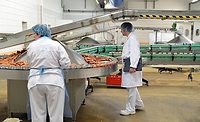The longer you work in the food industry, the more you realize Murphy’s law applies. After all, who hasn’t seen something that confirms the adage, “Anything that can go wrong, will go wrong?"
In the food industry, one way to head off potential problems, or at least minimize them, is to take the time to build well-thought-out food quality, safety and sanitation programs that ensure the production of safe foods. In other words: Do it right the first time.
When I was working on an overseas project a few years ago, I was invited to the grand opening of a pickle plant where fermented and fresh-pack products were going to be produced. The owners proudly talked about how they had incorporated the basic principles of sanitary design in the facility. But, when I saw the production floor, I had to tell them they had a major problem: They had not sealed the concrete floor, and the acid brines were going to destroy it in short order.
Floors are often given short shrift when a new plant is being built or modifications are being made to an existing facility. However, failing to select the proper materials or doing something on the cheap is asking for trouble. This is especially true if the company is producing and packing a ready-to-eat (RTE) product, since damaged floors are hard (or impossible) to clean properly and can become reservoirs for Listeria monocytogenes.
You also must make sure equipment is installed correctly. It may take a little longer, but think of it as an investment in the future. Part of installing equipment right the first time involves asking the following questions:
- Can this system be properly cleaned?
- Are conveyors accessible for cleaning?
- Can the pipes used for fluming or conveying product be adequately cleaned?
How you manage change also is important. For example, when a change is being contemplated, the food safety team or another group should conduct a risk assessment of it. Some questions that need to be answered are: Will the change be beneficial? Will it compromise food safety? These issues must be addressed because failing to properly evaluate a change could end up adversely affecting production efficiencies, food safety or even worker safety.
Developing, documenting, implementing and maintaining procedures that ensure the food safety management system remains in control are essential parts of change management programs. Also necessary are programs to properly train the workforce on procedures and how to document work is not only being done but done properly.
Doing something right the first time provides you with the necessary documentation to evaluate any problems that occur. These records also allow you to make the necessary corrections or implement a corrective action program to address the root cause of the problem to ensure it does not happen again.
The 2008 tomato/pepper outbreak underscores the importance of well-organized and well-managed traceability and recall programs. FDA and CDC originally implicated tomatoes as the causative agent. The situation was magnified because FDA did not trust the recordkeeping and food safety programs the tomato industry had implemented. As a result, tomato growers nationwide suffered massive losses unnecessarily, since the source of the outbreak wasn’t tomatoes at all; Serrano and jalapeño peppers were to blame.
However, this story has a silver lining. The tomato industry learned from the outbreak and has since placed a greater emphasis on traceability and recall efforts. Other members of the food industry should follow suit by implementing effective food quality, safety and sanitation programs— and doing it right the first time.



